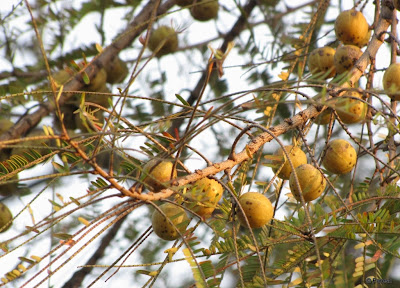Mahua or Mohwa (Madhuca Latifolia/मोह, मोहवा) is large, handsome, deciduous or semi-evergreen tree native to India. It has thick leathery leaves and small, fleshy, dull white musk-scented flowers which appear beautifully in clusters near the end of branches.
Mahua is one of the most important tree in the tribal belt of Central India and that’s too because of its delicious & nutritive flowers. The tree has got cultural and economic importance. Though it starts flowering after 10 years of age, once established the flower production increases with age. The flowers are edible and rich source of sugar, protein, vitamin & minerals. Mahua is a significant source of food for tribal people in Central & Western India. Its sweet flowers are eaten unprocessed or cooked.
Though almost all of flowers collected in tribal region is utilised for liquor production, there is huge potential and technologies available for product diversification of Mahua. Mahua concentrate is extracted from fresh Mahua flowers and can be used for making non-alcoholic Mahua products like jams, jellies and squash. Dried flowers can be used in making Mahua pickle, Mahua kismis and other food items like bakery and confectionery goods. Mahua oil is mostly used in the soap manufacturing.
From the seed kernels (fruits), a yellow oily substance is extracted, further processed and refined which is called Mahua Butter. Possibly, it gives the tree its name Butter tree. It is largely used by the jungle tribes for cooking or else sold for making soap & candles. The residue makes a good manure and is widely used on lawns as a worm eradicator. It is also widely used in skin ointments as it melts immediately upon contact with the skin. It prevents drying of the skin and may hinder the wrinkle development, it reduces degeneration of skin cells & restores skin flexibility. The tree is also a potential source for Biodiesel.
The Mahua tree truly justifies its botanical name madhuca which means sweet in Sanskrit. It is sweet to everyone, everything and everywhere..isn't it?! :-)
Mahua is one of the most important tree in the tribal belt of Central India and that’s too because of its delicious & nutritive flowers. The tree has got cultural and economic importance. Though it starts flowering after 10 years of age, once established the flower production increases with age. The flowers are edible and rich source of sugar, protein, vitamin & minerals. Mahua is a significant source of food for tribal people in Central & Western India. Its sweet flowers are eaten unprocessed or cooked.
Though almost all of flowers collected in tribal region is utilised for liquor production, there is huge potential and technologies available for product diversification of Mahua. Mahua concentrate is extracted from fresh Mahua flowers and can be used for making non-alcoholic Mahua products like jams, jellies and squash. Dried flowers can be used in making Mahua pickle, Mahua kismis and other food items like bakery and confectionery goods. Mahua oil is mostly used in the soap manufacturing.
Mahua is also one of important Agroforestry species. Its leaves, flowers and fruits are lopped for goats and sheep. Seed cake is also fed to cattle. Mahua oil is used to treat seeds against pest infestation. Mahua has a large spreading superficial root system that holds soil together, thereby help in erosion control. Still it can be raised with agricultural crops. Mahua can grow on and be used for reclamation of wasteland with hard lateritic soils. Furthermore the vesicular-arbuscular mycorrhizal associations and root colonization have been observed in Mahua. The seed cake has been used as cheap organic manure and possess insecticide property. The wide spreading crown provides shade for animals. Mahua is occasionally planted as an avenue tree or along the boundaries of fields.
From the seed kernels (fruits), a yellow oily substance is extracted, further processed and refined which is called Mahua Butter. Possibly, it gives the tree its name Butter tree. It is largely used by the jungle tribes for cooking or else sold for making soap & candles. The residue makes a good manure and is widely used on lawns as a worm eradicator. It is also widely used in skin ointments as it melts immediately upon contact with the skin. It prevents drying of the skin and may hinder the wrinkle development, it reduces degeneration of skin cells & restores skin flexibility. The tree is also a potential source for Biodiesel.
The fruits too, both ripe and unripe, are valuable, all parts being used. The outer coat is eaten as a vegetable and the inner one dried and ground into meal. Animals, particularly deer and bears, love the fallen flowers. Birds, too, enjoy them and peafowl can often be seen around the trees at sunset and dawn. Cut flowers, stems and branchlets exude a thick, milky sap which is extremely sticky and astringent. It is used for curing rheumatism. Many plants with a milky secretion are poisonous, but that is certainly not the case with the Mahua. Medicinally, it has immense usefulness ranging from common, everyday illness to chronic ones like bronchitis, rheumatism, diabetes, pile or bleeding gums.
The Mahua tree truly justifies its botanical name madhuca which means sweet in Sanskrit. It is sweet to everyone, everything and everywhere..isn't it?! :-)










